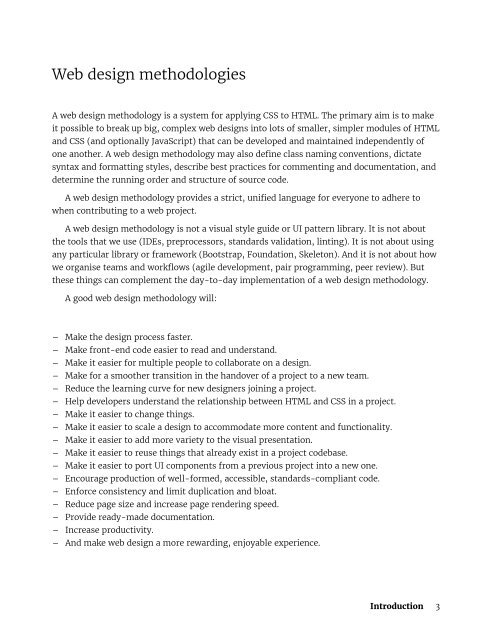systematic-css
systematic-css
systematic-css
You also want an ePaper? Increase the reach of your titles
YUMPU automatically turns print PDFs into web optimized ePapers that Google loves.
Web design methodologiesA web design methodology is a system for applying CSS to HTML. The primary aim is to makeit possible to break up big, complex web designs into lots of smaller, simpler modules of HTMLand CSS (and optionally JavaScript) that can be developed and maintained independently ofone another. A web design methodology may also define class naming conventions, dictatesyntax and formatting styles, describe best practices for commenting and documentation, anddetermine the running order and structure of source code.A web design methodology provides a strict, unified language for everyone to adhere towhen contributing to a web project.A web design methodology is not a visual style guide or UI pattern library. It is not aboutthe tools that we use (IDEs, preprocessors, standards validation, linting). It is not about usingany particular library or framework (Bootstrap, Foundation, Skeleton). And it is not about howwe organise teams and workflows (agile development, pair programming, peer review). Butthese things can complement the day-to-day implementation of a web design methodology.A good web design methodology will:––Make the design process faster.––Make front-end code easier to read and understand.––Make it easier for multiple people to collaborate on a design.––Make for a smoother transition in the handover of a project to a new team.––Reduce the learning curve for new designers joining a project.––Help developers understand the relationship between HTML and CSS in a project.––Make it easier to change things.––Make it easier to scale a design to accommodate more content and functionality.––Make it easier to add more variety to the visual presentation.––Make it easier to reuse things that already exist in a project codebase.––Make it easier to port UI components from a previous project into a new one.––Encourage production of well-formed, accessible, standards-compliant code.––Enforce consistency and limit duplication and bloat.––Reduce page size and increase page rendering speed.––Provide ready-made documentation.––Increase productivity.––And make web design a more rewarding, enjoyable experience.Introduction 3


